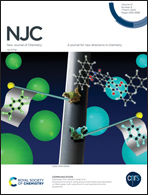A highly efficient visible-light-driven photocatalytic fuel cell with ZnIn2S4/PANI/TiO2/Ti photoanode for simultaneous degradation of rhodamine B and electricity generation
Abstract
To expand the optical absorption range and charge transfer efficiency of photoanode, the ZnIn2S4/PANI/TiO2/Ti photoanode was developed using a coating method and applied in a photocatalytic fuel cell (PFC) system for the removal of organic pollutants and chemical energy recovery. The prepared photoanode obtained a maximum photocurrent density of 4.19 mA cm−2 (1.2 V vs. SCE). The rhodamine B (RhB) removal efficiency, maximum power density (Pmax) and short-circuit current density (Jsc) of PFC constructed with the ZnIn2S4/PANI/TiO2/Ti composite photoanode and Cu cathode were 93.80% (1 h), 18.83 μW cm−2 and 0.26 mA cm−2, respectively. The improved photocatalytic activity of PFC was due to the outstanding photoelectric properties of the ZnIn2S4/PANI hybrid material, in which PANI, as a photosensitizer, promoted the absorption of visible light by the photoanode. The photoexcited electrons of ZnIn2S4 and PANI tend to be directly transferred to the CB of TiO2, while holes accumulate in the VB of PANI to participate in the oxidation reaction. The synergistic effect accelerates the separation of photogenerated electron–hole pairs and improves the photoelectric conversion efficiency of PFC.



 Please wait while we load your content...
Please wait while we load your content...